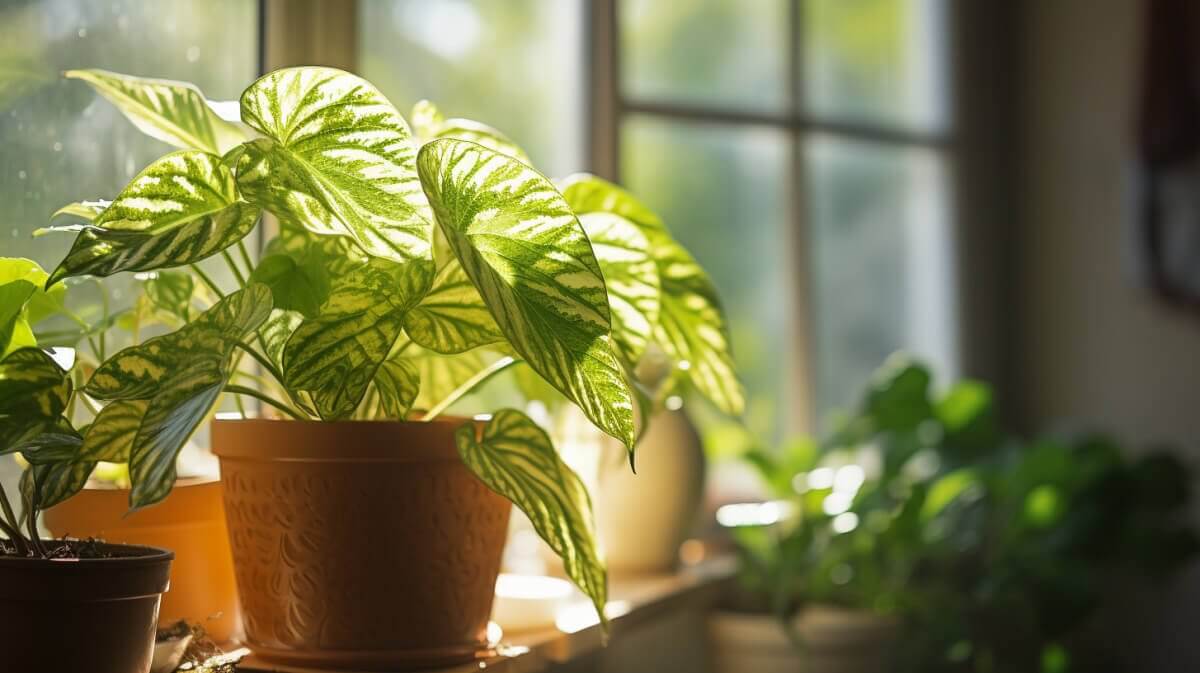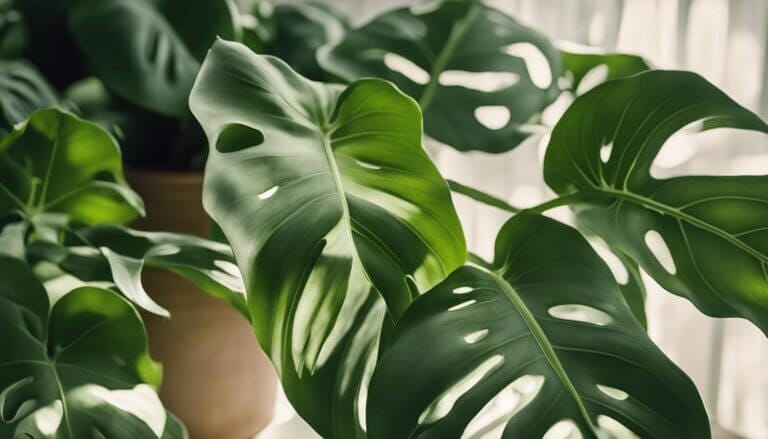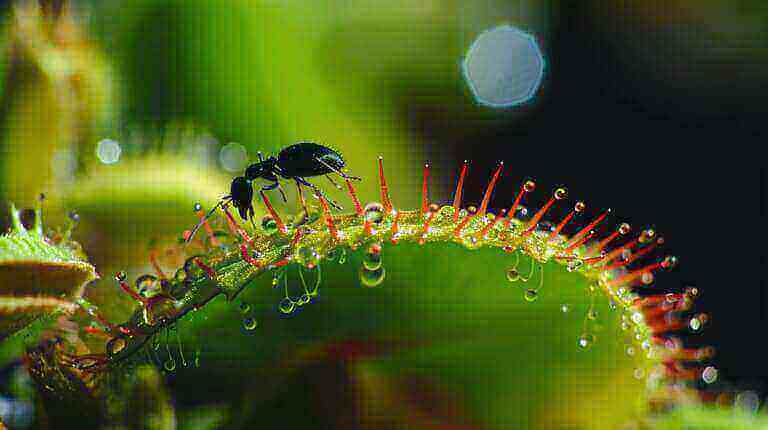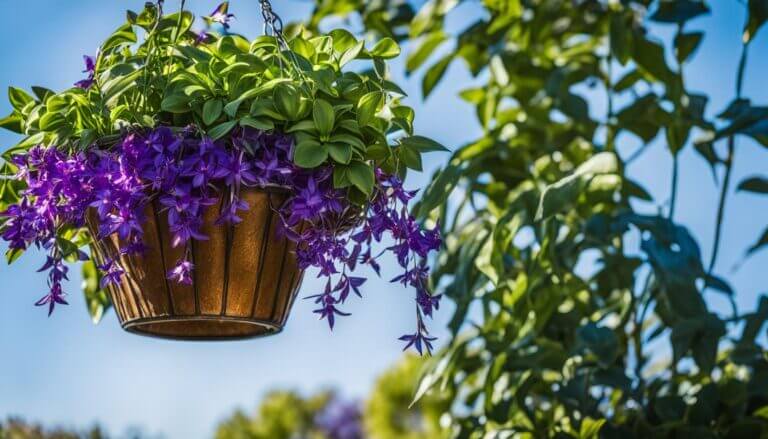Ready to help your arrowhead plant thrive? Find out just how much sun this Syngonium podophyllum needs to flourish.
Discover the ideal sunlight conditions, understand the plant’s light requirements, and learn how to find the perfect spot in your home. But remember, avoiding direct sunlight is crucial!
We’ll also guide you on adjusting sunlight exposure for different seasons. With our expert tips, you’ll create the perfect environment for your arrowhead plant, ensuring it feels right at home.
Let’s get started!
Key Takeaways
- Arrowhead Plant needs 4-6 hours of filtered sunlight per day
- Direct sunlight should be avoided as it can scorch the leaves
- Mimic the plant’s natural environment of filtered light
- Avoiding direct sunlight promotes optimal growth and health
Ideal Sunlight Conditions
To ensure optimum growth and health, your Arrowhead Plant Syngonium Podophyllum needs its ideal sunlight conditions. Sunlight duration and optimal light intensity are crucial factors for the well-being of your plant.
The Arrowhead Plant thrives in bright, indirect light, making it perfect for indoor environments. It requires at least 4-6 hours of filtered sunlight per day to promote healthy growth. However, direct sunlight should be avoided as it can scorch the leaves.
To achieve the ideal light intensity, place your plant near a window with sheer curtains or use a sheer curtain to filter the sunlight. This will provide the necessary amount of light without causing any harm. Remember to rotate your plant regularly to ensure even exposure to sunlight and prevent it from leaning towards the light source.
Understanding the Plant’s Light Requirements
To understand the plant’s light requirements, you should know that Arrowhead Plant Syngonium Podophyllum thrives in bright, indirect light. This means that it needs a good amount of light, but direct sunlight should be avoided as it can lead to leaf burn and discoloration. This plant is native to the tropical rainforests of South America, where it grows under the canopy of taller trees, receiving filtered light. Mimicking this environment is key to maximizing growth and preventing leaf problems. To help you better understand the light requirements of the Arrowhead Plant, take a look at the table below:
| Light Intensity | Light Duration | Light Quality |
|---|---|---|
| Bright, indirect | 10-12 hours/day | Filtered, dappled light |
If you notice any leaf discoloration or browning, it could indicate that the plant is receiving too much direct sunlight. Adjust the location of your plant accordingly, moving it to an area with more shade or using sheer curtains to filter the light. Remember, providing the right amount and quality of light will contribute to the overall health and beauty of your Arrowhead Plant.
Finding the Perfect Spot for Your Arrowhead Plant
Now, let’s explore where you can find the perfect spot to place your Arrowhead Plant for optimal growth and health. Here are some expert tips to help you choose the right spot and prevent overwatering:
- Light Requirements:
- Place your Arrowhead Plant in bright, indirect light.
- Avoid direct sunlight, as it can scorch the leaves.
- A north or east-facing window is ideal.
- Humidity Levels:
- Arrowhead Plants thrive in high humidity.
- Consider placing your plant in a bathroom or near a humidifier.
- You can also create humidity by placing a tray of water near the plant or misting the leaves regularly.
- Pot Size:
- Choose a pot that provides ample room for the plant’s roots to grow.
- A pot that’s too small can restrict growth and lead to root rot.
- Opt for a pot with drainage holes to prevent waterlogged soil.
- Watering:
- Arrowhead Plants prefer moist but not soggy soil.
- Water your plant when the top inch of soil feels dry.
- Avoid overwatering, as it can lead to root rot and other issues.
Avoiding Direct Sunlight: Why It’s Important
Avoiding direct sunlight is crucial for the optimal growth and health of your Arrowhead Plant, as it can scorch the leaves and hinder its overall development.
While sunlight is essential for photosynthesis, excessive exposure to direct sunlight can lead to potential sun damage. Direct sunlight can cause the leaves of your Arrowhead Plant to become scorched, resulting in brown, dry patches or even sunburn. These damaged leaves aren’t only unsightly but also affect the plant’s ability to carry out photosynthesis effectively.
Adjusting Sunlight Exposure for Different Seasons
Adjusting the amount of sunlight your Arrowhead Plant receives is crucial for its growth and health. Here are four key considerations to keep in mind for each season:
- Spring: Gradually increase sunlight exposure. Start with a few hours of indirect sunlight each day and gradually increase the duration over a few weeks.
- Summer: Protect your plant from direct sunlight. Provide filtered or indirect light by placing it near a window with a sheer curtain or in a location with dappled shade.
- Fall: Reduce sunlight exposure as the days become shorter. This will help prepare the plant for winter months.
- Winter: Your Arrowhead Plant requires less sunlight during this season. Place it in a well-lit area away from direct sunlight, such as a north-facing window or artificial grow lights.
Frequently Asked Questions
How Often Should I Water My Arrowhead Plant Syngonium Podophyllum?
To properly care for your arrowhead plant, watering it regularly is crucial. The frequency of watering depends on various factors such as the size of the pot, the humidity levels, and the temperature.
As a general rule, it’s best to water your arrowhead plant when the top inch of soil feels dry. Remember to also consider the humidity needs of your plant. Syngonium podophyllum prefers high humidity, so misting the leaves or placing a tray of water nearby can help create a suitable environment for its growth.
What Is the Best Temperature Range for an Arrowhead Plant to Thrive?
To ensure your arrowhead plant thrives, it’s crucial to maintain the best humidity levels and provide an ideal pot size.
The temperature range that promotes optimal growth for this plant is between 60°F and 85°F (15°C – 29°C).
Maintaining humidity levels of 50% to 60% will create a comfortable environment for your arrowhead plant.
Additionally, choosing a pot that allows for proper drainage and provides enough space for the plant’s roots to grow is essential for its overall health and thriving.
Can I Use Artificial Light to Provide the Necessary Sunlight for My Arrowhead Plant?
To provide the necessary sunlight for your arrowhead plant, you can use artificial light.
While natural sunlight has its advantages, artificial light also offers benefits. It allows you to control the intensity and duration of light exposure, ensuring optimal growth conditions for your plant.
Additionally, artificial light can be adjusted to meet the specific light requirements of arrowhead plants, promoting healthy foliage and vibrant colors.
With the right setup, your arrowhead plant can thrive under artificial light.
Are There Any Specific Soil Requirements for an Arrowhead Plant?
When it comes to your arrowhead plant’s soil requirements, you want to make sure you’re giving it the VIP treatment. The right soil composition is key for its thriving success. Aim for a well-draining mix that’s rich in organic matter. This will provide the perfect balance of moisture retention and aeration.
As for watering frequency, the goal is to keep the soil consistently moist but not soggy. Finding that sweet spot will ensure your arrowhead plant feels right at home.
How Often Should I Fertilize My Arrowhead Plant and With What Type of Fertilizer?
To ensure optimal growth and health of your arrowhead plant, it’s essential to provide the right fertilization frequency and use the appropriate fertilizer types.
Fertilize your plant every two weeks during the growing season, and reduce it to once a month during the dormant period.
Choose a balanced, water-soluble fertilizer with an NPK ratio of 20-20-20 or a similar formulation. This will supply essential nutrients, promoting vigorous growth and vibrant foliage for your arrowhead plant.







